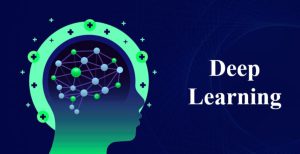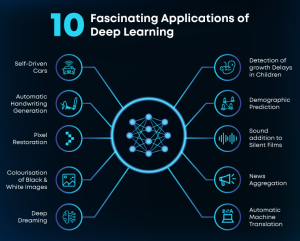Unlocking the Power of Deep Learning
In the ever-evolving landscape of artificial intelligence (AI), deep learning has emerged as a game-changer. This powerful subset of machine learning has redefined the possibilities of what computers can achieve, from image and speech recognition to natural language processing and autonomous decision-making. In this comprehensive guide, we will dive deep into the world of deep learning, exploring its fundamentals, applications, challenges, and the future it holds.
 Understanding Deep Learning
Understanding Deep Learning
At its core, deep learning is a subfield of machine learning that draws inspiration from the structure and function of the human brain. It involves training artificial neural networks to perform tasks by processing and interpreting data. The term “deep” refers to the use of multiple layers in neural networks, allowing for hierarchical feature representation and abstraction.
Key Concepts in Deep Learning
- Neural Networks: The foundational building blocks of deep learning are artificial neural networks. These networks consist of interconnected layers of nodes (neurons) that process and transform data.
- Deep Neural Networks (DNNs): DNNs are neural networks with multiple hidden layers, enabling them to model complex relationships and extract intricate patterns from data.
- Activation Functions: Activation functions introduce non-linearity to neural networks, enabling them to approximate complex functions. Common activation functions include ReLU (Rectified Linear Unit), sigmoid, and tanh.
- Backpropagation: Backpropagation is a learning algorithm used to train neural networks. It involves adjusting the network’s weights and biases based on the difference between predicted and actual outputs.
- Convolutional Neural Networks (CNNs): CNNs are specialized deep neural networks designed for tasks involving grids of data, such as images. They employ convolutional layers to extract features hierarchically.
- Recurrent Neural Networks (RNNs): RNNs are suited for sequential data, making them ideal for tasks like natural language processing. They have loops that allow information to persist through time steps.
 Applications of Deep Learning
Applications of Deep Learning
Deep learning has found applications in a wide range of domains, reshaping industries and revolutionizing technology:
- Computer Vision: Deep learning powers image recognition, object detection, and facial recognition systems, making it a cornerstone of computer vision applications. It’s used in autonomous vehicles, surveillance, and medical imaging.
- Natural Language Processing (NLP): In NLP, deep learning models are employed for tasks like sentiment analysis, language translation, and chatbots. Technologies like GPT (Generative Pre-trained Transformer) have achieved groundbreaking results in text generation.
- Speech Recognition: Deep learning underpins automatic speech recognition (ASR) systems, making voice assistants like Siri and Alexa possible. It’s also applied in transcription services and voice-controlled devices.
- Healthcare: Deep learning aids in medical diagnosis, predicting diseases from medical images, and drug discovery. It has the potential to significantly improve patient care and outcomes.
- Finance: Deep learning is used for fraud detection, algorithmic trading, and risk assessment. It helps financial institutions make data-driven decisions in real-time.
- Autonomous Systems: In self-driving cars and drones, deep learning algorithms process sensor data to make split-second decisions, ensuring safety and efficiency.
- Entertainment: Recommendation systems in platforms like Netflix and Spotify rely on deep learning to provide personalized content suggestions.
Challenges and Limitations
While deep learning has made remarkable strides, it is not without its challenges:
- Data Requirements: Deep learning models often require vast amounts of labeled data for training, which can be expensive and time-consuming to acquire.
- Computational Resources: Training deep neural networks demands significant computational power, limiting access for smaller organizations and individuals.
- Interpretability: Deep learning models can be seen as “black boxes” because understanding how they arrive at decisions can be challenging.
- Overfitting: Deep learning models can become overly complex and fit the training data too closely, leading to poor generalization on unseen data.
- Ethical Concerns: The use of deep learning in areas like facial recognition and bias in AI algorithms have raised ethical concerns around privacy and fairness.
The Future of Deep Learning
As deep learning continues to advance, several trends and developments are shaping its future:
- Transfer Learning: Transfer learning allows pre-trained models to be fine-tuned for specific tasks, reducing the need for extensive training data.
- Explainable AI: Researchers are working on making deep learning models more interpretable, addressing the “black box” challenge.
- Edge AI: Edge computing, where AI processing happens on devices rather than in centralized data centers, is gaining momentum. This will enable real-time, low-latency applications.
- Quantum Computing: The potential of quantum computing may revolutionize deep learning by addressing the computational demands of training complex models.
- Ethical AI: Efforts to ensure AI fairness, transparency, and accountability will continue to evolve.
In conclusion, deep learning has ushered in a new era of AI capabilities, pushing the boundaries of what machines can achieve. Its applications span numerous industries, from healthcare to finance, and its potential for transformative change is still being explored. While challenges persist, ongoing research and innovation promise to unlock even more remarkable capabilities in the world of deep learning, shaping the future of AI in ways we can only imagine.

